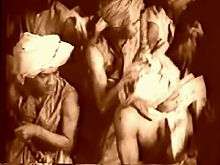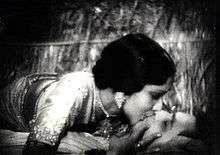Karma (1933 film)
| Karma | |
|---|---|
 Karma | |
| Directed by | J.L. Freer Hunt |
| Written by | Rupert Downing |
| Story by | Dewan Sharar |
| Starring | |
| Music by | Ernst Broadhurst |
Release dates |
|
Running time | 68 mins.[1] |
| Country |
|
| Language | English, Hindi |
Karma is a 1933 bilingual film starring Devika Rani and Himanshu Rai. The film was directed by J.L. Freer Hunt and was a joint production among India, Germany and United Kingdom. Karma featured a four-minute kissing scene between the lead actors—Devika Rani and Rai—the longest in an Indian film.
Plot
The story is about a princess (played by Devika Rani) who falls in love with a neighbouring prince much to the disapproval of the latter's father.
Production
The female lead Devika Rani, the grand niece of Nobel laureate Rabindranath Tagore was professionally associated with Rai even before the two married in 1929.[2] Impressed by her talent, Rai decided to cast her in the film alongside him. Abraham Sofaer was cast in a pivotal role as a "Holy Man".[3][1] The screenplay was co-written by Rai and Freer Hunt.[1] The music was composed by German composer Ernst Broadhurst. Devika Rani had recorded a song in the film including the Hindi version.[4]
Karma, an "Indo-German-British" collaboration, was released two years after the Alam Ara (1931), the first Indian talkie. Karma was made targeting the international audience.[4] The film was entirely shot in India while the post-production process was carried out in Stoll Studios, London.[3] The film was the first talkie produced by Rai.[5]
Release

The film initially premiered in London in May 1933. Devika Rani's performance was lauded by the critics in London. However, when the film was released later in Hindi as Naagan Ki Raagini, it failed to impress the Indian audience.[6][7][8]
The film was among the first in India to feature an on-screen kiss.[7][9] The four-minute long scene between Devika Rani and Rai, her husband in real life, is also known to being the longest such scene in Indian cinema.[4][5] Upon release, the film became controversial in the then "orthodox India" for featuring a kissing scene.[2]
Legacy
Though largely ignored in India during its release, Karma is considered a landmark in Indian cinema due to its unprecedented kissing scene. In 2012, The Times of India described it as the "first Indian talkie with English dialogue which set all London talking".[7]
Notes
- 1 2 3 McFarlane 1999, p. 157.
- 1 2 Saran 2014, p. 27.
- 1 2 Patel 2012, p. 57.
- 1 2 3 "Karma 1933". The Hindu. 10 January 2009. Retrieved 7 April 2014.
- 1 2 Jaikumar 2006, p. 229.
- ↑ Varma, Madhulika (26 March 1994). "Obituary: Devika Rani". The Independent. Retrieved 7 April 2014.
- 1 2 3 Dasgupta, Priyanka (30 April 2012). "India's longest kissing scene clips in Paoli film". The Times of India. Retrieved 7 April 2014.
- ↑ Purohit 1988, p. 995.
- ↑ "100 Years of Cinema: History of the kiss – sexually liberated 1930s to prudish 21st century". IBNLive. Retrieved 8 April 2014.
References
- Patel, Bhaichand (2012). Bollywood's Top 20: Superstars of Indian Cinema. Penguin Books Limited. ISBN 978-81-8475-598-5.
- McFarlane, Brian (1999). Lance Comfort. Manchester University Press. ISBN 978-0-7190-5484-6.
- Jaikumar, Priya (2006). Cinema at the End of Empire: A Politics of Transition in Britain and India. Duke University Press. ISBN 0-8223-3793-2.
- Saran, Renu (2014). Encyclopedia of Bollywood–Film Actresses. Diamond Pocket Books Pvt Ltd. ISBN 978-93-5083-691-0.
- Purohit, Vinayak (1988). Arts of Transitional India Twentieth Century. Popular Prakashan. ISBN 978-0-86132-138-4.